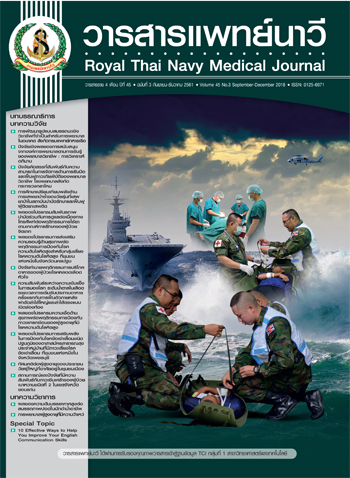The Comparative Study of Resilience to Amphetamine Relapse among Adolescent Amphetamine Users in the Institute on Drug Abuse Treatment
Main Article Content
Abstract
The objectives of this research were 1) to explore resilience to amphetamine relapse among adolescent amphetamine users, 2) to compare resilience to amphetamine relapse among adolescent amphetamine users between voluntary system and compulsory system, and 3) to compare resilience to amphetamine relapse among adolescent amphetamine users between difference severities of amphetamine use groups. The development of the Resilience to Amphetamine Relapse scale was from resilience to drug use concept to create questioning to collect qualitative data in the context of Thai's adolescent drug use. The questionnaire
consisted of six elements of the ability to successfully deal with resilience amphetamine relapse. Data collection in adolescent amphetamine users aged 12 - 24 years receiving treatment in the Princess Mother National Institute on Drug Abuse Treatment (Thanyarak Hospital) 4 setting 366 persons in Pathum Thani, Khon Kaen, Songkhla and Chiang Mai. The research instruments consisted of 1) personal data questionnaire,
2) the Resilience to Amphetamine Relapse scale, and 3) the Severity of Amphetamine Use. Data were analyzed by frequency, percentage, mean, standard deviation. Independent t-test, One Way ANOVA and
Post hoc analysis were used for the comparative study of resilience to amphetamine relapse among adolescent amphetamine users.
The results showed that
1. Adolescent amphetamine users were admitted in voluntary system 55.2% and admitted in compulsory system 44.8 %.
2. The perceived of resilience to amphetamine relapse among adolescent amphetamine users were at the high level 48.9% followed by the highest level 40.7%, the medium level 9.6% and low level to minimal level 0.8%
3. Comparison of perceived resilience to amphetamine relapse among adolescent between voluntary and compulsive system found adolescents who received voluntary system had a significantly higher mean score (X̅ = 170.69) than adolescents receiving compulsory system (X̅ = 164.30) (t = 2.67; p < .05).
4. The scores of perceived resilience to amphetamine relapse among adolescent between differences perceived severity of amphetamine use found the period of continued amphetamines use group had a higher resilience to amphetamine relapse (X̅ = 169.75) than those in the preoccupation with amphetamine use group (X̅ = 164.07) and the comparison of different group of perceived severity of amphetamine use were significantly resilience to amphetamine relapse score different (F = 2.822, p-value < .05) by group difference were between group of continue to use and group of obsessed with amphetamine (Sig = .034, pvalue < .05).
Article Details

This work is licensed under a Creative Commons Attribution-NonCommercial-NoDerivatives 4.0 International License.
References
ศูนย์อำนวยการและป้องกันยาเสพติดแห่งชาติ. แผนป้องกันและแก้ไขปัญหายาเสพติดเร่งด่วน ปี 2561. [อินเทอร์เน็ต]. [เข้าถึงเมื่อ 22 มิถุนายน 2561]. แหล่งที่มา: https://www.ppb.moi.go.th/midev03/upload/ppb2561.pdf
สำนักบริหารการสาธารณสุข สำนักปลัดกระทรวงสาธารณสุข. ระบบรายงาน ระบบติดตามและเฝ้าระวังปัญหายาเสพติด (บสต. 1-5). [อินเทอร์เน็ต]. [เข้าถึงเมื่อ 22 มิถุนายน 2561]. แหล่งที่มา: https://antidrug.moph.go.th
กรมสุขภาพจิต. เวชสถิติผู้ป่วยในบำบัดสุราและสารเสพติดแบบประเมินทางสังคม. [อินเทอร์เน็ต]. [เข้าถึงเมื่อ 27 มีนาคม 2561]. แหล่งที่มา: https://www.dmh.go.th/abstract/nurse/details.2508
Calipari ES, Ferris MJ. Amphetamine mechanisms and actions at the dopamine terminal revisited. [Internet]. [cited 2017 May 24]. Available from: https://www.ncbi.nlm.nih.gov/pmc/articles/PMC3753078/pdf/nihms492057.pdf.
Nilaban S, Sriherun B, Kongthong U. Causal relationship of factors relapsing behavior of methamphetamine users. Journal of Graduate Studies Valaya Alongkron Rajabhat University 2016; 10(1): 193-207. (in Thai).
สถาบันธัญญารักษ์. จำนวนและร้อยละการบำบัดซ้ำในปีงบประมาณ 2560. [อินเทอร์เน็ต]. [เข้าถึงเมื่อ 6 มกราคม 2561]. แหล่งที่มา: www.thanyarak.go.th/thai/index.php?option.
Office of the Narcotics Control Board, United Nations Office on Drugs and Crime. World drug report. [Internet]. [cited 2018 December 28]. Available from: https://information.oncb.go.th.
Marlatt GA, Gordon JR. Relapse prevention: maintenance strategies in the treatment of addictive behaviors. New York: Guilford press; 1985.
Chaipichitpan N. A study of factors affecting amphetamine relapsing behavior of secondary school students treated in Thanyarak Hospital. [Master’s Thesis, Faculty of Educaion]. Chulalongkorn University. 1998. (in Thai).
Suwannanon A, Bannatham R, Chotnipat W, Nooplab S. Personal factors related to be relapse. Bangkok : Drug Users Office of the Narcotics Control Board; 2007. (in Thai).
Thatsananchalee P. The process of non becoming amphetamine addict: a case study of rehabilitated person in process of correctional system. Interdisciplinary Sripatum Chonburi Journal 2011;1(3):36-48. (in Thai).
Hawkins JD, Catalano RF, Miller JY. Risk and protective factors for alcohol and other drug problems in adolescence and early adulthood: implications for substance abuse prevention. Psychol Bull 1992;112(1):64-105.
Braverman MT. Research on resilience and its implications for tobacco prevention. Nicotine Tob Res 1999;1 Suppl 1:S67-72.
Meschke LL, Patterson JM. Resilience as a theoretical basis for substance abuse prevention. The Journal of Primary Prevention 2003;23(4):483-514.
Dillon L, Chivite-Matthews N , Grewa I, Brown R , Webster S, Weddell E, et al. Risk, protective factors and resilience to drug use: identifying resilient young people and learning from their experiences. National centre for Social Research; 2007.
Luthar SS, Cicchetti D, Becker B. The construct of resilience: a critical evaluation and guidelines for future work. Child Dev 2000;71(3):543–62.
Fraser MW, Kirby LD, Smokowski PR. Risk and resilience in childhood. In Fraser MW, editor. Risk and resilience in childhood: an ecological perspective. Washington D.C.: National Association of Social Workers. 2004. p. 13-66.
Costello AB, Osborne JW. Best practices in exploratory factor analysis: four recommendations for getting the most from your analysis. Practical Assessment Research & Evaluation 2005;10(7):1-9.
สถาบันธัญญารักษ์. คู่มือการบำบัดรักษาผู้ติดยาเสพติด. กรุงเทพมหานคร: องค์การสงเคราะห์ทหารผ่านศึก; 2546.
Benard B. Fostering resiliency in kids: protective factors in the family, school and community. Portland, OR: Northwest Regional Educational Laboratory; 1991.
Ryan RM, Deci EL. Self-determination theory and the facilitation of intrinsic motivation, social development, and well-being. Am Psychol 2000;55(1):68-78.
Panchabuse C. Saengduenchai S. The effectiveness of cognitive-behavioral therapy program on early relapse prevention among methamphetamine-dependent patients. Journal of Nursing Division 2013;40(1):24-38. (in Thai).
Netnualyai R, Nitchanet C, Bhukong S, Boonyapithak S, Phukao D. Thai youth’s voluntary applications of drug treatment. Journal of Association of Researchers 2014;19(2):36-44. (in Thai).
Pattrakorn A, Chaipichitpan N. The effect of FAST model for addiction patient in Thanyarak Institute. J Psychiatr Assoc Thailand 2015;60(1):71-81. (in Thai).
Jitpong W. Severity of relapse to methamphetamine dependence in patients with history of substance-dependency treatment at the inpatient department, Thanyarak Institute on drug abuse. [Master’s Thesis, Faculty of Medicine]. Chulalongkorn University. 2009. (in Thai).


